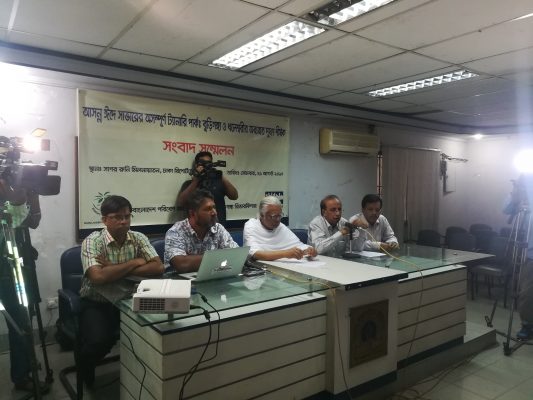Incomplete Tannery Park of Savar in the Upcoming Eid: Buriganga and Dhaleshwari’s Ongoing Pollution

Buriganga Riverkeeper and Bangladesh Poribesh Andolon (BAPA) jointly organized a Press Conference on “Incomplete Tannery Park of Savar in the Upcoming Eid: Buriganga and Dhaleshwari’s Ongoing Pollution’’ on 21 August 2017, Monday at 11:00 AM, at Sagar-Runi Conference Hall, Dhaka Reporters’ Unity (DRU), Segun Bagicha, Dhaka. Eminent civil society personality, columnist and Vice President of BAPA Syed Abul Maksud presided over the meeting while Sharif Jamil, Buriganga Riverkeeper and Joint Secretary, BAPA delivered the keynote presentation. Dr. Mohd. Abdul Matin, General Secretary, BAPA, Professor Badrul Imam, University of Dhaka, BAPA Joint Secretaries Shajahan Mridha Benu, Mihir Bishwas and Alamgir Kabir also attended the press conference among other.

More than half of the world’s leather industries have been developed in low and middle-income countries. And Bangladesh is one of the many countries that has been producing leather products over the past few decades. In recent years, annual income of Bangladesh from leather industries was approximately more than $1 billion. According to the Banglapedia’s information about the history of tannery industry in Bangladesh, it has been discovered that Randaprasad Saha established the first tannery in 1940 in the district of Narayanganj. After a while this tannery was shifted from Narayanganj to Dhaka’s Hazaribagh. A number of tannery industries were established based in Hazaribagh after the independence. This number increased dramatically and more than 90% of Bangladesh’s tannery industry was established in Hazaribagh on 25 hectares of land. According to various media reports, more than 230 tannery industries were set up in Hazaribagh.
Tannery industries of Hazaribagh has been one of the main sources of Buriganga River pollution for a long time. For the past 45 years, these tanneries have been polluting the river by releasing more than 40 heavy metals including Chromium. 21,000 cubic meter of crude waste was being released to the river from Hazaribagh tanneries every day. According to the statistics of Bangladesh Department of Environment (DoE), around 95% of the tanneries have been established without a proper infrastructure and plan throughout the last 50 years. Additionally, a recent study found that approximately 60,000 tons of leather processing was done every year, from which about 95,000 liters of untreated sewage was released every day directly into the Buriganga River.
On July 15 2001, the Honorable High Court (HC) gave the first order to take effective measures against Hazaribagh tannery pollution as well as to shift the tanneries within one year. Until July 08 2017, the HC failed several times to shift the Hazaribagh tanneries to Savar. Finally, the HC issued an order to cut down the electricity supply of the Hazaribagh tannery which initiated the relocation of the tannery industries to Savar’s Tannery Park.
Nearly, 200 acres of land has been acquired for the purpose of establishing an environmentally friendly tannery industrial estate located by the bank of Dhaleshwari River near Dhaka. Plots have been distributed among 155 tannery companies in the acquired area. In the meantime, the majority of tannery companies that have allocated plots, are continuing their relocation process. At present, 2 modules of Central Effluent Treatment Plant (CETP) are operational, and two more are in progress, which is expected to be commissioned soon. But the total waste storage capacity of the entire plant is 25,000 cubic meters. However, the amount of waste will increase after Eid. At present, about 70 tanneries are producing between 12,000-15,000 cubic meters of waste, which are going directly into the Dhaleshwari River without any treatment. It is necessary to reevaluate the efficiency of ETP by examining them scientifically.

Dhaleshwari pollution is an indispensable issue because there is no way to refine and manage solid waste, salt and chromium. A Chinese Company working on this project has given a proposal to the Government to implement a Solid Waste Management system by 2019. Around 100 factories from Hazaribagh are still not in the list of allotment. Several factories have been continuing their operation in Hazaribagh by taking illegal power connections lines from the nearby households and from dishonest government electricity distributer.
The worst fact is that, the pollution of the Dhaleshwari River would increase to a larger extent after Eid-ul-Adha, to be celebrated in the first week of September. Savar Tannery Park’s pollution has been expanding beyond the Buriganga, Dhaleshwari and Kaliganga. While, there is no confirmation when these factories would run with proper ETP implementation. Despite our continuous movement, some issues like poor planning & management, ETP limitations, employment, education and health have not been properly highlighted. Since the CETP of Savar is a biological treatment plant, its efficiency depends on the amount of waste; the time taken for modules to process; and the amount of caustic soda as well as other ingredients, which is either faulty or non-existent.
Newslinks of the event is given below:
News Links (English Dailies)
- New Age: http://www.newagebd.net/article/22531/hope-for-eco-friendly-tannery-park-at-savar-fading:-speakers-
- The Dailystar: http://www.thedailystar.net/city/dhaleshwari-buriganga-face-heavier-pollution-during-eid-1452253
- All Events BD: https://allevents.in/dhaka/press-conference-on-savars-incomplete-tannery-park-pollution/109925349700546
News Links (Bangla Dailies)
- Observer BD: http://www.observerbd.com/bn/details.php?id=1585
- Kaler-kantha: http://www.kalerkantho.com/print-edition/news/2017/08/22/534658
- Daily Nayadiganta: http://www.dailynayadiganta.com/detail/news/246129
- Poriborton: http://www.poriborton.com/import-export/67978
- Bangla News 24: http://www.banglanews24.com/national/news/bd/596790.details
- Bangladesh Protidin: http://www.bd-pratidin.com/city/2017/08/22/258165
